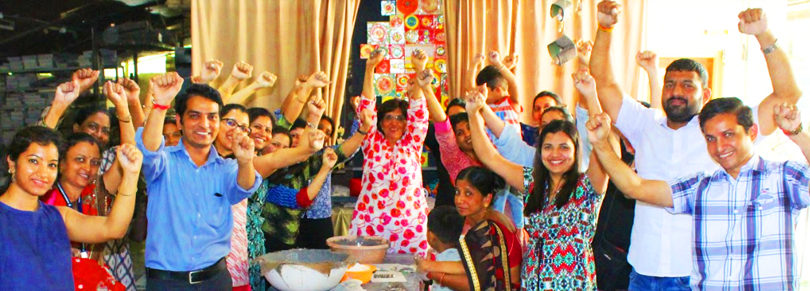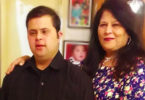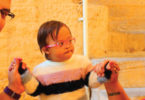My first exposure to a special needs child goes back 40 years. Mona was born to our neighbors a few months before my son, Aditya, in 1976. It took a few years to realize that Mona was not growing at the same pace as Aditya. She took longer to walk, she often had a blank look. Standard preschools after a few months would request the parents to withdraw her from school. Mona’s family was so angry and distressed. They were in complete denial and sought no outside support. There was no social media, no Google where one could get some answers, even the medical fraternity completely ruled out any hope for these children.
My kids were growing up ‘normal’ and that filled me with a great sense of gratitude but honestly I did not make any special effort to reach out to this family. We never spoke about it – it was a no no topic.
It’s a boy!
Forty years later it was my turn as I waited excitedly for the arrival of my first grandchild. It was a boy! Palak, my daughter, and the baby were fine. Hearing this was a great relief but one look at the doctor and I sensed that something was amiss. A few minutes later the doctors told us that they suspected our newborn grandson had a special genetic condition.
As friends and relatives greeted us, I did not know whether to laugh or cry. Tears were rolling down my eyes but I tried hard to smile and accept the greetings, after all I had just become a grandmother! In the recovery room I smiled, congratulated Palak and pretended that all was well. That was the toughest part for me. We waited over the next two days hoping and praying that the blood report would set aside any doubts, but alas the reports confirmed that Advait was born with Trisomy 21 commonly known as Down syndrome.
The next few months were crazily painful. I tried hard to behave as normal as possible but my heart cried out. I could not believe this was happening to us. Each morning I tried convincing myself that this was only a bad dream, a nightmare. When Advait was two years old he was diagnosed with a large hole in his heart. It meant an open-heart surgery. Many more sleepless nights and many more anxious questions followed. After days of research and anxiety we identified a doctor who was able to perform a medical procedure using a catheter to close the hole in the heart. An open heart surgery was prevented.
Each milestone was a celebration
Advait healed rapidly, and strangely, I started healing with him. I watched Palak and Jesh handle the situation so bravely. Palak got into systematically training herself how best to bring up a child with Down syndrome. I took on the role of an assistant. I finally started learning and understanding more about this condition and what were the areas where I could be of help. Of course besides being a loving granny I wanted to be a part of his growing up.
Each milestone he covered, we as a family rejoiced and celebrated. As Advait grew, I was beginning to see Palak’s struggle of which school to choose for him and how to share his condition with parents of children whom Advait interacted with. As I began healing and accepting I was able to comfortably share Advait’s condition with my friends. They learnt to give me space without judgement. But I could see in most cases social acceptance was a huge question mark.
By the time Advait was three, I had learnt to enjoy him without fear. I took on small activities to help strengthen muscles and improve his fine motor skills. We would sit in my studio (I am a ceramic artist) and I would hand him a ball of soft cool clay and ask him to press hard on it. He loved the feeling of the moist clay and giggled as he kept releasing fists full of clay. I fired these forms in my studio and instantly fell in love with them, the whole idea and the love that was going into making these pieces.
I was starting a journey, a journey that has now become a vision and a mission.
I met another young mother, Shweta Runwal, whose six-year- old, Dhriti, also has Down syndrome. She is very active with the DS society of India. She has an NGO ‘Tickle my Heart’ where she supports Downs children through heart surgery.
I soon realized that we were not alone in this situation; there were so many special parents struggling to accept and feel accepted.
So together, Shweta and I thought of having group sessions to create a better understanding of special needs with standard/typical families resulting in “Mutthi – a fistful of clay” sessions.
Two open minded families working together with clay, creating something special together and interacting with one another.
It is our vision to create an open space for families to share stories, to overcome stigmas around special needs and to embrace their own needs.
We have two sessions a month, one session is at my studio Adipa and the other is at any other suitable venue like a school, art event, a drum circle session etc. Typically every session is a small group of (20 to 30) standard and special people. Each session starts with an introduction to why I call these sessions ‘Mutthi’. Aside from my own experience with Advait and clay, the Mutthi or a closed fist is very symbolic of holding, releasing and finally accepting what the universe has to offer. After the introductions, I share my own experiences allowing participants to relax and share their personal stories.
Slowly an atmosphere of hearing and caring starts building up enabling more and more people to verbalise some of their fears, frustrations and anxieties. Many participants have never interacted closely with a special member. So when they come across them they are nervous about how to approach them and their family. Fear of causing hurt keeps them at a distance, while on the other hand special families feel singled out and not accepted. We have realized that special families have a responsibility to share their special situation when in a social environment.
This helps typical members understand our specific special situations. They feel free to talk and connect with us. After this intimate session we have circle time, which is more or less a quiet healing, meditative experience. Then comes clay time when we all play and make clay artworks under the guidance of volunteers. Each participant makes a fist of clay with their name written on it. The session ends with a lot of laughter and sharing and getting to know each other. For me and my volunteers, each Mutthi session is a personal journey as we internalize the sharing of each session.
We are all truly different and each of us has our share of personal problems. No one issue is bigger or smaller – it is our attitude towards our problems that makes or breaks us. Each Mutthi session turns out to be so special and unique. All participants realize that we are basically loving, kind and caring humans being, we don’t often know how to express it. We all consciously focus on expressing gratitude for what we have. As an artist I wish to create a large art installation as a visual symbol of inclusion and acceptance.
This artwork will consist of elements made by hundreds of us who participate in these Mutthi sessions. An artwork that will belong to all of us with no single authorship. Artists and friends across the world are keen to conduct these sessions. I wish that by the end of this year I will be able to put up the first segment of the Mutthi installation somewhere, somehow.






Leave a Comment